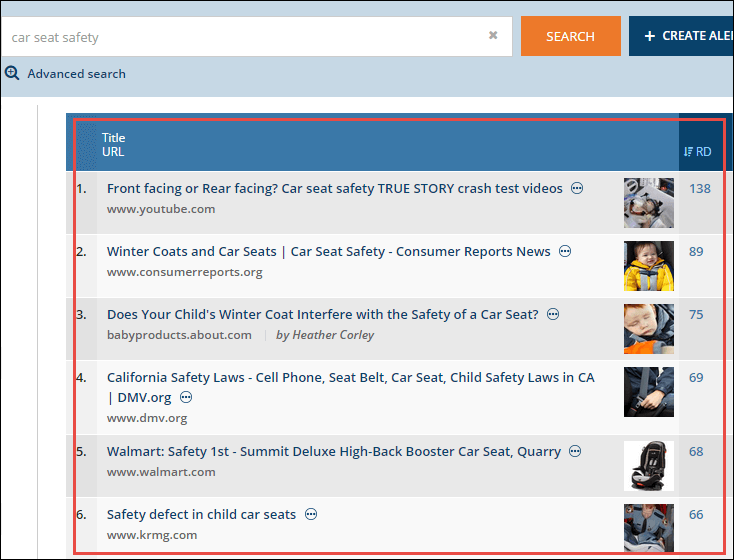Identifying & Capitalizing On “Link Inefficiencies” In Your Link Building
Got great content but not many links? Columnist Tom Demers explains how to find and create linking opportunities with your existing content.
Creating popular content is hard. The Web is littered with assets that were expensive, time-intensive, and difficult to create — yet wound up driving little to no traffic, links, shares, leads or sales.
There are various means of “fail proofing” your content creation efforts to help mitigate downside risk for new content assets you create, but most companies are operating with a limited budget and want to find ways to “do more with less.” One means of accomplishing this in your link building efforts is to identify existing “link inefficiencies” on your site.
When I talk about link inefficiencies, I’m referring to existing pieces of content on your site that are linkworthy but are not currently being linked to.
In this article, I’ll walk through how to identify which pages on your site represent a “link inefficiency” and discuss how you can go about capitalizing on that opportunity to get more value out of your existing assets.
Step 1: Self-Examination
Like a lot of areas in life, you need to start with some tough introspection. In this case, you need to ask: Do I actually have any link-worthy content?
If your last several blog posts look something like:
- Exciting News! (Small feature release about your site most of your visitors may not even care about).
- We’ll be at (Conference lots of other people will be at, with no additional information about the conference or what you’ll be doing there).
- Our Take on (Trending Topic, which pivots away from the trending topic in the second sentence to talk about how great your product is and why none of the bad things in the industry would be happening if everyone wised up and used your product).
There’s a good chance you might not have much to work with. In that case, you may want to think about creating some more compelling content and actually ensure that your content ideas are going to be linkable.
Step 2: Auditing Your Own Content
Assuming you did some soul-searching and are, in fact, creating content that would be worth sharing and linking to, you can start to identify the content assets on your own site where there’s a gulf between linkability, content quality and actual links. This isn’t exactly the same process as a traditional content audit, so let’s take a look at the tools and processes you can use to find these opportunities.
My favorite tool for this type of research is Ahrefs, as it gives a quick view of shares alongside link and referring domain data. You can get some of the same data from tools like BuzzSumo, Moz and Majestic SEO, as well (If you want to get more data and make your own decision about whose link graph to leverage, check out this great in-depth look at the various indexes by Russ Jones).
For the purposes of this post, we’ll look at a home/family safety site my company owns and operates with Ahrefs data. The first step here is to get an export of data for your domain. Simply input your domain, and then drill down to top pages and export that data:
As you look at the export of data from your domain, what you’re looking for are pages that are frequently shared but not linked to. In many cases, this will mean you (or whoever created and promoted the content initially) hit a nerve with a topic and got great social distribution but didn’t find the right way to support that same content with link outreach.
A quick and dirty way to filter this data is to simply look at the ratio of shares to referring domains, and pull out the pages that have an unusually high share to referring domain ratio:
For now, just add those URLs to a spreadsheet. (We’ll work on evaluating those and actually building new links to those pages later in the article.)
Now that you’ve got link data for key URLs, you can apply a similar methodology to glean useful insights. Consider viewing a couple of other metrics in conjunction with links:
- Referral Traffic & Referring Domains. By looking at your referral traffic in your analytics tool of choice, you can find content assets that are driving a lot of traffic from other sites (meaning those sites’ audiences likely find the page very relevant) that have a limited number of total referring domains. Sites similar to those that are sending you traffic currently may be interested in adding a link to your resource.
- Organic Traffic & Referring Domains. Looking at pages that are currently driving organic traffic but have low link numbers could be another great way to identify content that may be interesting to other sites. Consider these pages for your outreach efforts. (Again, though, be honest with yourself about the quality of the page. If a short sales or product page is ranking well, that’s great — but it may not be something you can reasonably expect to build quality links to.)
Another inefficiency you may be able to unearth in your content is linkable topics that don’t currently have links. How do you know if something is a linkable topic?
Take topics you’ve created high-quality content around (or mediocre/shorter form content that you could enhance — more on that in the next section of the article), and look for those topics in Ahrefs’ content explorer, sorting the results by referring domains:
Look more closely at the content assets here that have high link counts:
- Are they high-quality?
- Are they on sites that are similar to yours?
- Are they getting links that your asset could be getting?
If you have a topic for which there are definitively achievable links available, add that to your list.
Step 3: Evaluating Your “Linkable” Pages & Getting Links
Now that you have a big list of pages that you suspect are linkable (and if you don’t, go back to step one and work on creating better content), you can start to determine where there are actually links available for these pages and then go get those links.
A. Pages With Prospecting & Outreach Opportunities
For the topics where you’re seeing high numbers of quality links in research like that outlined in step two, you can start to use link lists from existing assets to build a list of outreach targets.
As you evaluate assets that had heavy share counts, you can apply the same methodology: Where are the assets that are heavily linked to around that topic? What sites (and types of sites) link to them? Can you go and get those links with your own outreach?
Not every heavily shared piece of content will be a great linkable asset, but many of the pages on your site that were a hit on social media could likely get you more traction if you layered in some additional prospecting and outreach to those assets, or if you added other types of content to make the asset more linkable (by making it more comprehensive and/or adding another type of media, such as video, a graphic, a slide deck, a widget or something else).
If you’re not sure how to get from having an existing asset to actually prospecting, conducting outreach and getting links in to that page, there are a lot of great resources to walk you through those topics, including:
- Jon Cooper’s excellent, comprehensive (paid) course on link building and his post on prospecting and big list of link building tactics.
- Will Blunt’s guide to blogger outreach.
- Matthew Barby’s guide to crafting the perfect Email pitch.
- Brian Dean’s ultimate guide to Link Building.
- Garrett French’s Link Building Book.
- Linkarati’s comprehensive list of link building resources.
B. Pages that Are Good “Nepotistic Link Targets”
Traditional link building prospecting and outreach aren’t the only ways to get additional links to an asset, either. There are various elements you may control that offer you a chance to get more exposure for your asset, such as:
- Link To It On Your Site. Do you have assets or sections of your site that receive a lot of traffic from folks who may be in a position to link to content (such as your blog’s navigation if your blog is popular, a specific post you’ve done that’s frequently referenced or the landing page for a popular industry report you’ve created)? Just by mentioning or highlighting some of your other linkable (but under-linked-to) assets, you may be able to get more attention for them and ultimately new links to them.
- Link To It from Contributed Content & Press Releases. If you contribute to other blogs or put out press releases, highlighting your own content assets that have been shared or focusing on a linkable topic can be a great way to get more exposure for those assets, assuming they’re high-quality and informational.
- Paid Social Ads. Some specifically targeted paid social promotion for your content can be a great way to get added exposure with influencers and linkers. Even if your work got a lot of shares and social exposure previously, paid targeting can get you the right kind of exposure to help net you links.
It’s often the case that creating a new asset from scratch to map to a specific linking audience offers you the best return when you’re looking to build links and drive more search engine traffic to your site, but you might also have a lot of existing, untapped opportunities hiding in plain sight within your content, so consider taking a closer look at your own link inefficiencies before you start fresh.
Contributing authors are invited to create content for Search Engine Land and are chosen for their expertise and contribution to the search community. Our contributors work under the oversight of the editorial staff and contributions are checked for quality and relevance to our readers. The opinions they express are their own.
Related stories
New on Search Engine Land



